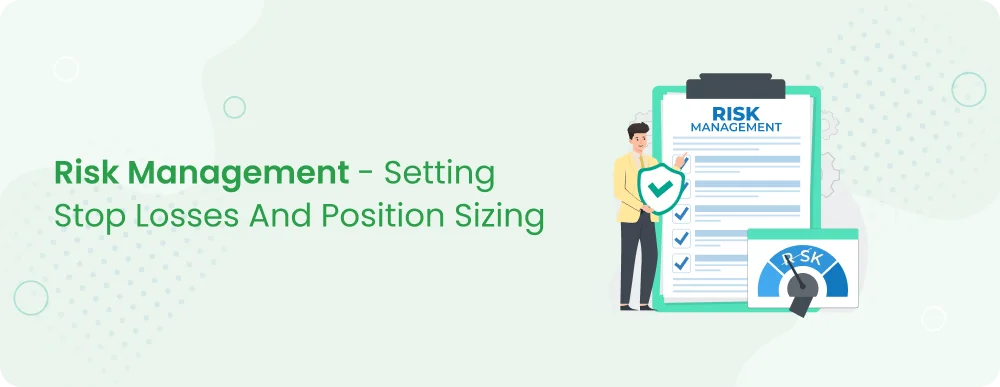Risk Management in Trading: Stop Losses and Position Sizing Explained
Noor Kaur
24 Jan 2025Tags:
Featured
Effective risk management in trading revolves around minimising potential losses while maximising opportunities. Two key components of this process are stop losses and position sizing.
Stop-loss orders act as safeguards, automatically closing trades when prices move against you beyond a set limit. Meanwhile, calculating the right position sizing ensures you risk only a manageable portion of your capital on each trade. Let’s understand this in a little more detail.
What Is Risk Management in Trading?
Risk management in trading refers to a structured approach traders use to protect their capital when markets move against them. It involves identifying, analysing, and minimising potential losses before they grow into major setbacks. A strong risk management plan includes limiting position sizes, setting predefined stop losses, diversifying trades, and managing exposure to volatile or uncertain market conditions.
The primary goal of risk management is not to avoid losses altogether—because every trader faces losing trades—but to ensure that losses remain smaller than potential profits. This is where concepts like the risk–reward ratio come into play. By choosing trades where the expected reward outweighs the potential risk, traders can maintain long-term profitability even if only a portion of their trades are successful.
Without proper discipline and a clear framework, traders may struggle to exit losing positions on time. Many hold onto bad trades hoping for reversals, which can lead to larger losses or even account wipeouts. Effective risk management provides guardrails, helping traders stay consistent, protect capital, and build a sustainable trading approach over time.
Understanding Stop Losses
A stop-loss order is a critical tool in financial risk management. It allows you to sell a security when it reaches a specific price, limiting your losses on a trade. Setting stop-loss levels correctly requires careful consideration of factors like market volatility, entry price, and your overall risk management process.
Type of Stop Losses
Choosing the right type of stop loss depends on your trading strategy and risk tolerance. Here are the common types:
- Fixed Stop Loss: This option allows you to set a predetermined price level for closing your trade. It’s simple and widely used in the risk management process.
- Trailing Stop Loss: Adjusts as the market moves in your favour, locking in profits while limiting potential losses. This is especially useful for traders who want to let profits run.
- Percentage-Based Stop Loss: This strategy determines the stop loss based on a specific percentage of your account balance or trade size. It is often used as a financial risk management strategy.
- Time-Based Stop Loss: Closes a trade if it doesn’t meet specific conditions within a set timeframe, helping you stick to your risk management plan.
Understanding Position Sizing
Position sizing is deciding how much capital to allocate to a single trade. It is a key part of risk management and helps you limit potential losses while maximising opportunities. A well-thought-out risk management plan involves calculating your position size based on your account size, risk tolerance, and the distance between your entry point and setting stop loss levels.
Calculating Position Size
Calculating position size is a key part of risk management in trading. It helps you determine the amount of capital to allocate to a trade, ensuring your potential loss stays within acceptable limits. Here’s a simple formula and explanation:
- Determine Risk Per Trade: Decide what percentage of your total trading capital you will risk on a single trade. In risk management, risking 1-2% is common.
- Identify Stop Loss Level: Set a stop-loss price (the point where you will exit the trade to limit losses). This is crucial for setting stop loss effectively.
- Calculate Risk Amount: Multiply your total capital by the risk percentage. For example, if your capital is ₹10,000 and you’re risking 2%, the risk amount is ₹200.
- Find Position Size: Divide the risk amount by the difference between the entry and stop-loss prices (your risk per unit). For instance:
- If your entry price is ₹100 and the stop-loss price is ₹95, your risk per unit is ₹5.
- Position size = ₹200 ÷ ₹5 = 40 units.
Relationship Between Stop Losses and Position Sizing
Stop losses and position sizing are critical components of a robust risk management plan. They work together to limit potential loss and help you trade within your risk tolerance.
- Stop Losses Define Risk Per Unit: A stop loss determines the amount of loss you are willing to accept per unit of the asset. This forms the basis of your risk calculation in the risk management process.
- Position Sizing Limits Overall Risk: By calculating position size based on your stop loss, you control the total amount of money at risk in the trade. For example, if your total risk is $200 and your stop loss is $5 per unit, your position size would be 40 units.
- Alignment with Risk Tolerance: Adjusting your position size based on the stop-loss distance ensures you follow your financial risk management strategy without risking too much capital.
Common Mistakes to Avoid
Avoiding common mistakes is essential for successful trading. Here are some frequent errors traders make and how to sidestep them:
- Ignoring Risk Management: Trading without a well-defined risk management plan can lead to unnecessary losses. Before entering the market, always determine your acceptable risk per trade.
- Not Setting Stop Losses: Failure to use stop-loss orders (predefined price levels at which a trade is automatically closed) can lead to significant losses. Prioritise setting stop-loss levels for every trade.
- Overleveraging: Using too much leverage (borrowing money to trade) can magnify profits and losses. Stick to manageable position sizes as part of your risk management process.
- Skipping Position Sizing: Avoid trading without calculating the right position sizing based on your account balance and risk tolerance. This helps maintain consistent trading discipline.
Best Practices
Adopting effective trading habits can help you achieve long-term success. Here’s how to improve your trading:
- Develop a Comprehensive Risk Management Plan: Outline your maximum acceptable risk per trade and total portfolio risk. A solid risk management plan helps protect your capital.
- Always Use Stop Losses: Set stop-loss orders for every trade to control potential losses and maintain discipline. This is a cornerstone of financial risk management.
- Focus on Position Sizing: Calculate the number of units to trade based on your stop-loss distance and risk tolerance. Proper position sizing ensures you don’t risk too much on a single trade.
- Keep Emotions in Check. Stick to your strategies and avoid making decisions based on fear or greed. Emotional trading often leads to mistakes.
Conclusion
Mastering stop-loss orders and proper position sizing is essential for successful risk management in trading. Stop-loss orders protect your capital by limiting losses, while proper position sizing prevents overexposure to individual trades. Integrating these tools into your trading approach creates a structured, disciplined process that reduces financial risk and helps you consistently achieve long-term trading goals.
Noor Kaur
24 Jan 2025Related blogs


How the Stock Market Works in India: A Guide | mastertrust
Have you ever wondered about the complexities of the stock market in India? If so, you're not alone. In this exten...


Role of Inflation in Long-Term Investment Planning
In Financial Planning, one of the things that plays a key role is the impact of inflation on your investments.


Understanding FERA vs. FEMA: Key Differences Explained | mastertrust
In the world of financial services and international trade, regulations play a crucial role in governing transaction


Understanding Negative Rate Bonds: Investor Strategies | mastertrust
Bonds are considered a popular investment avenue by Investors. The demand for negative yield bonds is on the rise
Sign up to our newsletter !
Share this article on
Recent articles
Tags:
Open a Demat Account in just 15 minutes !

Click on open
account below

Fill out some
basic details

Upload your
documents

Start trading in
24 Hours *
Commonly asked questions
Is Master Capital Services Limited SEBI registered?
Do you have a mobile app for Trading and Finance Management?
What services does mastertrust provide?
What is the minimum investment required to start trading with your company?
Is my personal and financial information secure with your company?
What is your customer support availability?





